Consumer Behavior Report: Yamaha Cygnus and Consumer Decision Making
VerifiedAdded on 2020/05/28
|8
|1543
|261
Report
AI Summary
This report provides a comprehensive analysis of consumer behavior, specifically examining the factors that influence purchasing decisions. The report begins with an introduction outlining the objectives and methodology, which includes a survey of 20 individuals to understand consumer patterns. It then delves into the purchase situation of the Yamaha Cygnus, a product priced at $5000, analyzing the high-involvement purchase process and the stages involved, from need recognition to post-purchase evaluation. The report also constructs a target market profile, detailing demographic, behavioral, and psychographic aspects of potential consumers. Furthermore, the report identifies and discusses various internal and external factors influencing consumer decision-making, such as motivation, lifestyle, and cultural influences, supported by a visual representation of these factors. The conclusion emphasizes the importance of understanding consumer behavior for successful product launches, and the report ends with a recommendation to target consumers with economic stability. References and appendices, including a diagram of influencing factors, are also included.
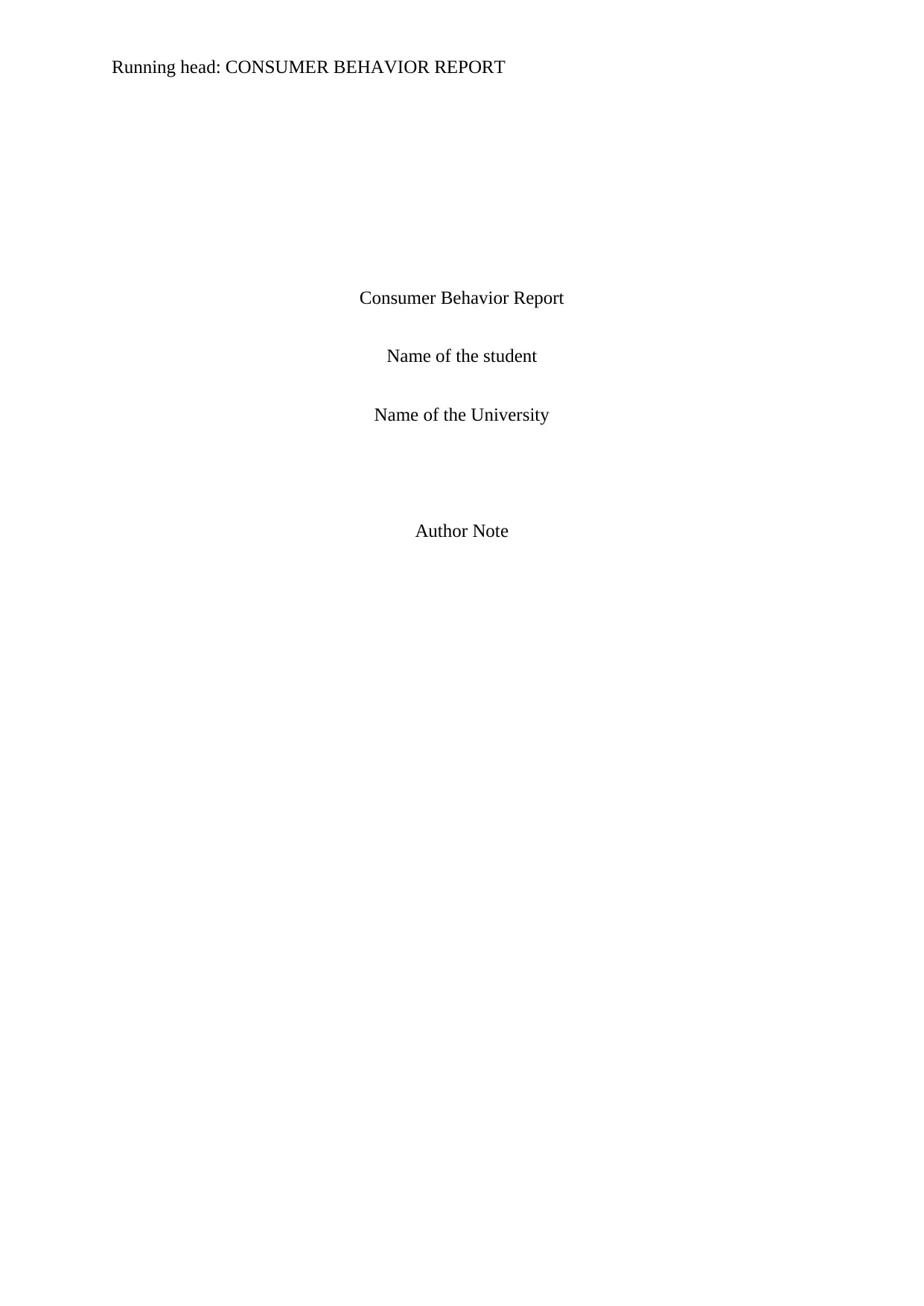
Running head: CONSUMER BEHAVIOR REPORT
Consumer Behavior Report
Name of the student
Name of the University
Author Note
Consumer Behavior Report
Name of the student
Name of the University
Author Note
Paraphrase This Document
Need a fresh take? Get an instant paraphrase of this document with our AI Paraphraser
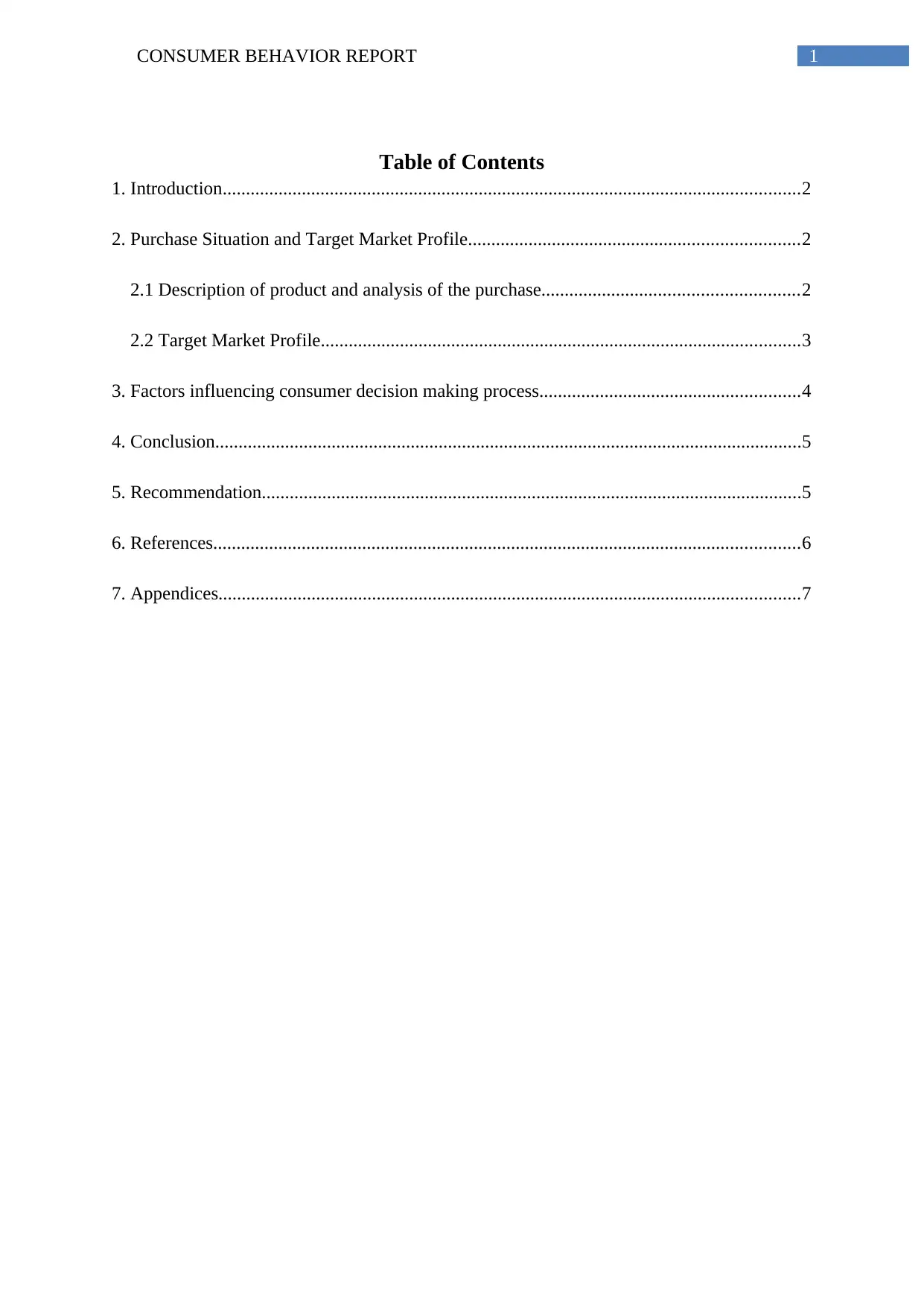
1CONSUMER BEHAVIOR REPORT
Table of Contents
1. Introduction............................................................................................................................2
2. Purchase Situation and Target Market Profile.......................................................................2
2.1 Description of product and analysis of the purchase.......................................................2
2.2 Target Market Profile.......................................................................................................3
3. Factors influencing consumer decision making process........................................................4
4. Conclusion..............................................................................................................................5
5. Recommendation....................................................................................................................5
6. References..............................................................................................................................6
7. Appendices.............................................................................................................................7
Table of Contents
1. Introduction............................................................................................................................2
2. Purchase Situation and Target Market Profile.......................................................................2
2.1 Description of product and analysis of the purchase.......................................................2
2.2 Target Market Profile.......................................................................................................3
3. Factors influencing consumer decision making process........................................................4
4. Conclusion..............................................................................................................................5
5. Recommendation....................................................................................................................5
6. References..............................................................................................................................6
7. Appendices.............................................................................................................................7
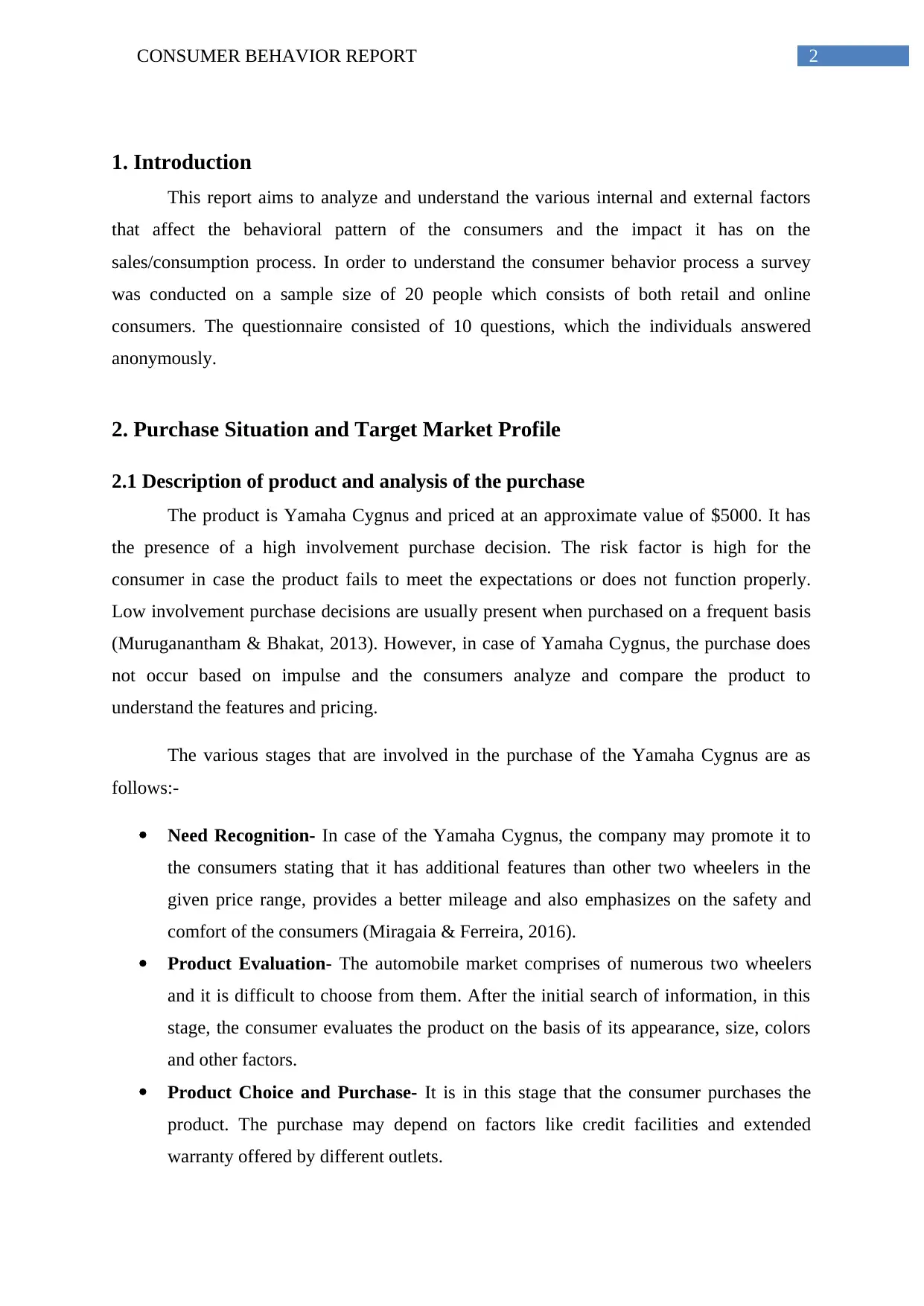
2CONSUMER BEHAVIOR REPORT
1. Introduction
This report aims to analyze and understand the various internal and external factors
that affect the behavioral pattern of the consumers and the impact it has on the
sales/consumption process. In order to understand the consumer behavior process a survey
was conducted on a sample size of 20 people which consists of both retail and online
consumers. The questionnaire consisted of 10 questions, which the individuals answered
anonymously.
2. Purchase Situation and Target Market Profile
2.1 Description of product and analysis of the purchase
The product is Yamaha Cygnus and priced at an approximate value of $5000. It has
the presence of a high involvement purchase decision. The risk factor is high for the
consumer in case the product fails to meet the expectations or does not function properly.
Low involvement purchase decisions are usually present when purchased on a frequent basis
(Muruganantham & Bhakat, 2013). However, in case of Yamaha Cygnus, the purchase does
not occur based on impulse and the consumers analyze and compare the product to
understand the features and pricing.
The various stages that are involved in the purchase of the Yamaha Cygnus are as
follows:-
Need Recognition- In case of the Yamaha Cygnus, the company may promote it to
the consumers stating that it has additional features than other two wheelers in the
given price range, provides a better mileage and also emphasizes on the safety and
comfort of the consumers (Miragaia & Ferreira, 2016).
Product Evaluation- The automobile market comprises of numerous two wheelers
and it is difficult to choose from them. After the initial search of information, in this
stage, the consumer evaluates the product on the basis of its appearance, size, colors
and other factors.
Product Choice and Purchase- It is in this stage that the consumer purchases the
product. The purchase may depend on factors like credit facilities and extended
warranty offered by different outlets.
1. Introduction
This report aims to analyze and understand the various internal and external factors
that affect the behavioral pattern of the consumers and the impact it has on the
sales/consumption process. In order to understand the consumer behavior process a survey
was conducted on a sample size of 20 people which consists of both retail and online
consumers. The questionnaire consisted of 10 questions, which the individuals answered
anonymously.
2. Purchase Situation and Target Market Profile
2.1 Description of product and analysis of the purchase
The product is Yamaha Cygnus and priced at an approximate value of $5000. It has
the presence of a high involvement purchase decision. The risk factor is high for the
consumer in case the product fails to meet the expectations or does not function properly.
Low involvement purchase decisions are usually present when purchased on a frequent basis
(Muruganantham & Bhakat, 2013). However, in case of Yamaha Cygnus, the purchase does
not occur based on impulse and the consumers analyze and compare the product to
understand the features and pricing.
The various stages that are involved in the purchase of the Yamaha Cygnus are as
follows:-
Need Recognition- In case of the Yamaha Cygnus, the company may promote it to
the consumers stating that it has additional features than other two wheelers in the
given price range, provides a better mileage and also emphasizes on the safety and
comfort of the consumers (Miragaia & Ferreira, 2016).
Product Evaluation- The automobile market comprises of numerous two wheelers
and it is difficult to choose from them. After the initial search of information, in this
stage, the consumer evaluates the product on the basis of its appearance, size, colors
and other factors.
Product Choice and Purchase- It is in this stage that the consumer purchases the
product. The purchase may depend on factors like credit facilities and extended
warranty offered by different outlets.
⊘ This is a preview!⊘
Do you want full access?
Subscribe today to unlock all pages.

Trusted by 1+ million students worldwide
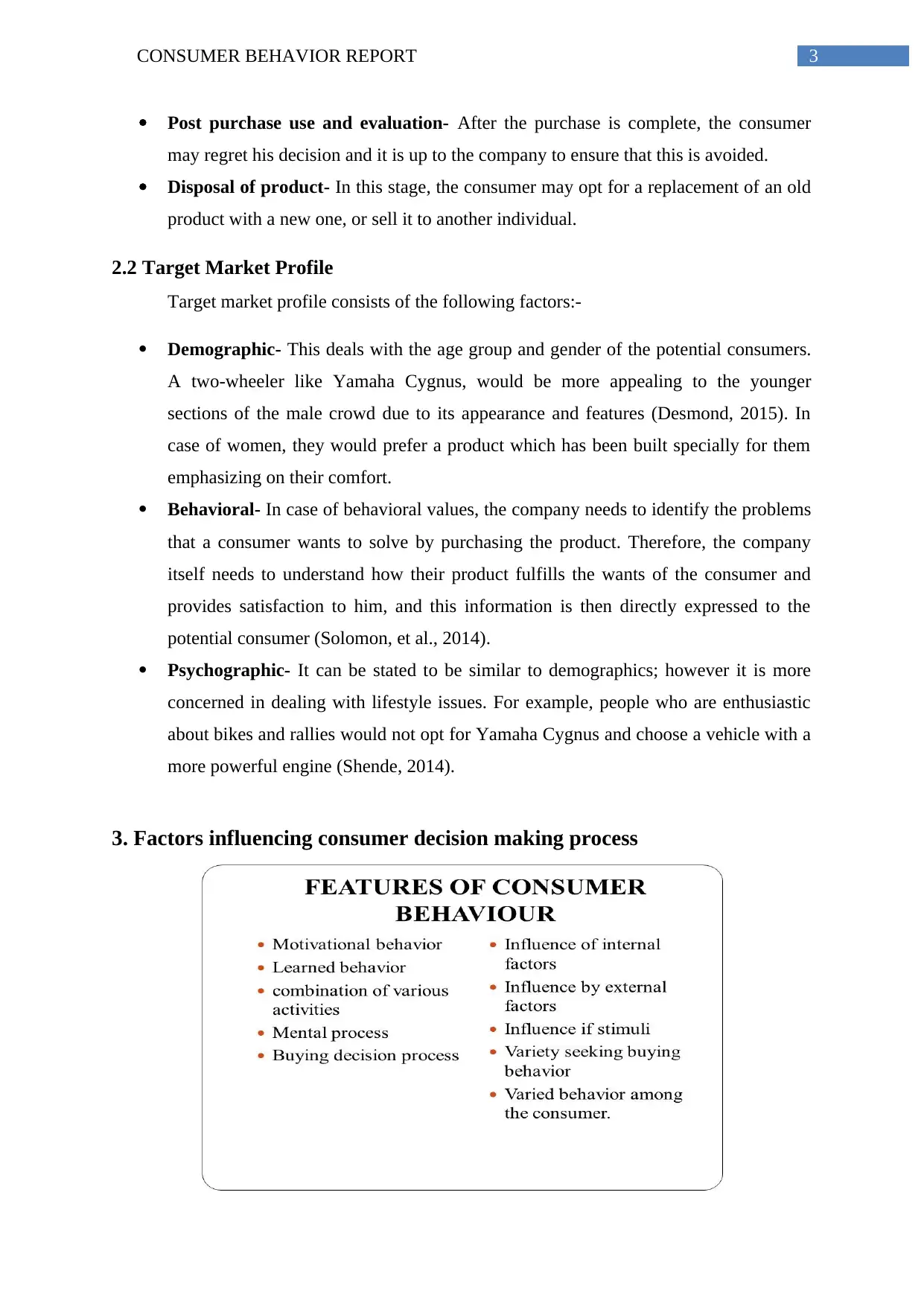
3CONSUMER BEHAVIOR REPORT
Post purchase use and evaluation- After the purchase is complete, the consumer
may regret his decision and it is up to the company to ensure that this is avoided.
Disposal of product- In this stage, the consumer may opt for a replacement of an old
product with a new one, or sell it to another individual.
2.2 Target Market Profile
Target market profile consists of the following factors:-
Demographic- This deals with the age group and gender of the potential consumers.
A two-wheeler like Yamaha Cygnus, would be more appealing to the younger
sections of the male crowd due to its appearance and features (Desmond, 2015). In
case of women, they would prefer a product which has been built specially for them
emphasizing on their comfort.
Behavioral- In case of behavioral values, the company needs to identify the problems
that a consumer wants to solve by purchasing the product. Therefore, the company
itself needs to understand how their product fulfills the wants of the consumer and
provides satisfaction to him, and this information is then directly expressed to the
potential consumer (Solomon, et al., 2014).
Psychographic- It can be stated to be similar to demographics; however it is more
concerned in dealing with lifestyle issues. For example, people who are enthusiastic
about bikes and rallies would not opt for Yamaha Cygnus and choose a vehicle with a
more powerful engine (Shende, 2014).
3. Factors influencing consumer decision making process
Post purchase use and evaluation- After the purchase is complete, the consumer
may regret his decision and it is up to the company to ensure that this is avoided.
Disposal of product- In this stage, the consumer may opt for a replacement of an old
product with a new one, or sell it to another individual.
2.2 Target Market Profile
Target market profile consists of the following factors:-
Demographic- This deals with the age group and gender of the potential consumers.
A two-wheeler like Yamaha Cygnus, would be more appealing to the younger
sections of the male crowd due to its appearance and features (Desmond, 2015). In
case of women, they would prefer a product which has been built specially for them
emphasizing on their comfort.
Behavioral- In case of behavioral values, the company needs to identify the problems
that a consumer wants to solve by purchasing the product. Therefore, the company
itself needs to understand how their product fulfills the wants of the consumer and
provides satisfaction to him, and this information is then directly expressed to the
potential consumer (Solomon, et al., 2014).
Psychographic- It can be stated to be similar to demographics; however it is more
concerned in dealing with lifestyle issues. For example, people who are enthusiastic
about bikes and rallies would not opt for Yamaha Cygnus and choose a vehicle with a
more powerful engine (Shende, 2014).
3. Factors influencing consumer decision making process
Paraphrase This Document
Need a fresh take? Get an instant paraphrase of this document with our AI Paraphraser
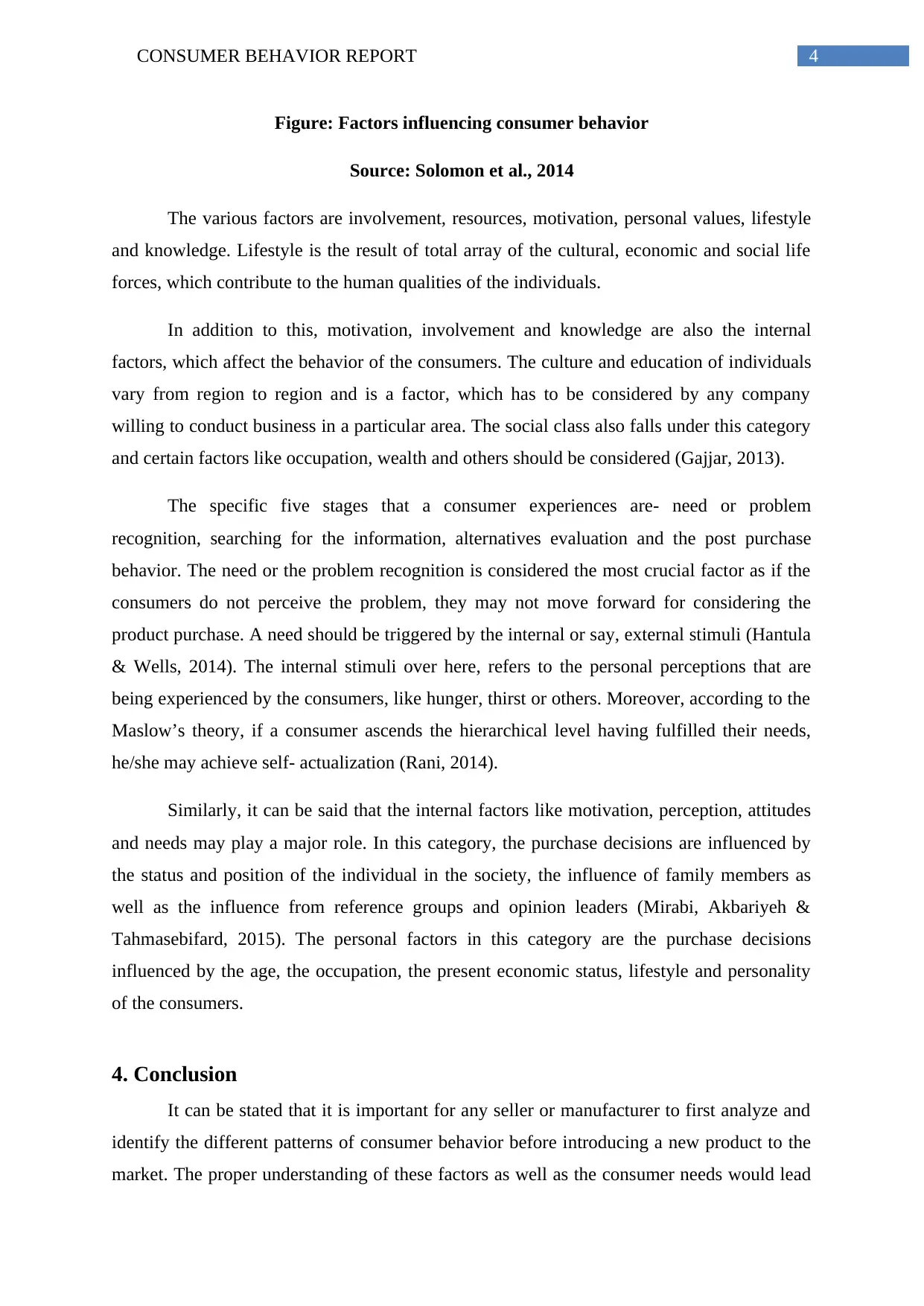
4CONSUMER BEHAVIOR REPORT
Figure: Factors influencing consumer behavior
Source: Solomon et al., 2014
The various factors are involvement, resources, motivation, personal values, lifestyle
and knowledge. Lifestyle is the result of total array of the cultural, economic and social life
forces, which contribute to the human qualities of the individuals.
In addition to this, motivation, involvement and knowledge are also the internal
factors, which affect the behavior of the consumers. The culture and education of individuals
vary from region to region and is a factor, which has to be considered by any company
willing to conduct business in a particular area. The social class also falls under this category
and certain factors like occupation, wealth and others should be considered (Gajjar, 2013).
The specific five stages that a consumer experiences are- need or problem
recognition, searching for the information, alternatives evaluation and the post purchase
behavior. The need or the problem recognition is considered the most crucial factor as if the
consumers do not perceive the problem, they may not move forward for considering the
product purchase. A need should be triggered by the internal or say, external stimuli (Hantula
& Wells, 2014). The internal stimuli over here, refers to the personal perceptions that are
being experienced by the consumers, like hunger, thirst or others. Moreover, according to the
Maslow’s theory, if a consumer ascends the hierarchical level having fulfilled their needs,
he/she may achieve self- actualization (Rani, 2014).
Similarly, it can be said that the internal factors like motivation, perception, attitudes
and needs may play a major role. In this category, the purchase decisions are influenced by
the status and position of the individual in the society, the influence of family members as
well as the influence from reference groups and opinion leaders (Mirabi, Akbariyeh &
Tahmasebifard, 2015). The personal factors in this category are the purchase decisions
influenced by the age, the occupation, the present economic status, lifestyle and personality
of the consumers.
4. Conclusion
It can be stated that it is important for any seller or manufacturer to first analyze and
identify the different patterns of consumer behavior before introducing a new product to the
market. The proper understanding of these factors as well as the consumer needs would lead
Figure: Factors influencing consumer behavior
Source: Solomon et al., 2014
The various factors are involvement, resources, motivation, personal values, lifestyle
and knowledge. Lifestyle is the result of total array of the cultural, economic and social life
forces, which contribute to the human qualities of the individuals.
In addition to this, motivation, involvement and knowledge are also the internal
factors, which affect the behavior of the consumers. The culture and education of individuals
vary from region to region and is a factor, which has to be considered by any company
willing to conduct business in a particular area. The social class also falls under this category
and certain factors like occupation, wealth and others should be considered (Gajjar, 2013).
The specific five stages that a consumer experiences are- need or problem
recognition, searching for the information, alternatives evaluation and the post purchase
behavior. The need or the problem recognition is considered the most crucial factor as if the
consumers do not perceive the problem, they may not move forward for considering the
product purchase. A need should be triggered by the internal or say, external stimuli (Hantula
& Wells, 2014). The internal stimuli over here, refers to the personal perceptions that are
being experienced by the consumers, like hunger, thirst or others. Moreover, according to the
Maslow’s theory, if a consumer ascends the hierarchical level having fulfilled their needs,
he/she may achieve self- actualization (Rani, 2014).
Similarly, it can be said that the internal factors like motivation, perception, attitudes
and needs may play a major role. In this category, the purchase decisions are influenced by
the status and position of the individual in the society, the influence of family members as
well as the influence from reference groups and opinion leaders (Mirabi, Akbariyeh &
Tahmasebifard, 2015). The personal factors in this category are the purchase decisions
influenced by the age, the occupation, the present economic status, lifestyle and personality
of the consumers.
4. Conclusion
It can be stated that it is important for any seller or manufacturer to first analyze and
identify the different patterns of consumer behavior before introducing a new product to the
market. The proper understanding of these factors as well as the consumer needs would lead
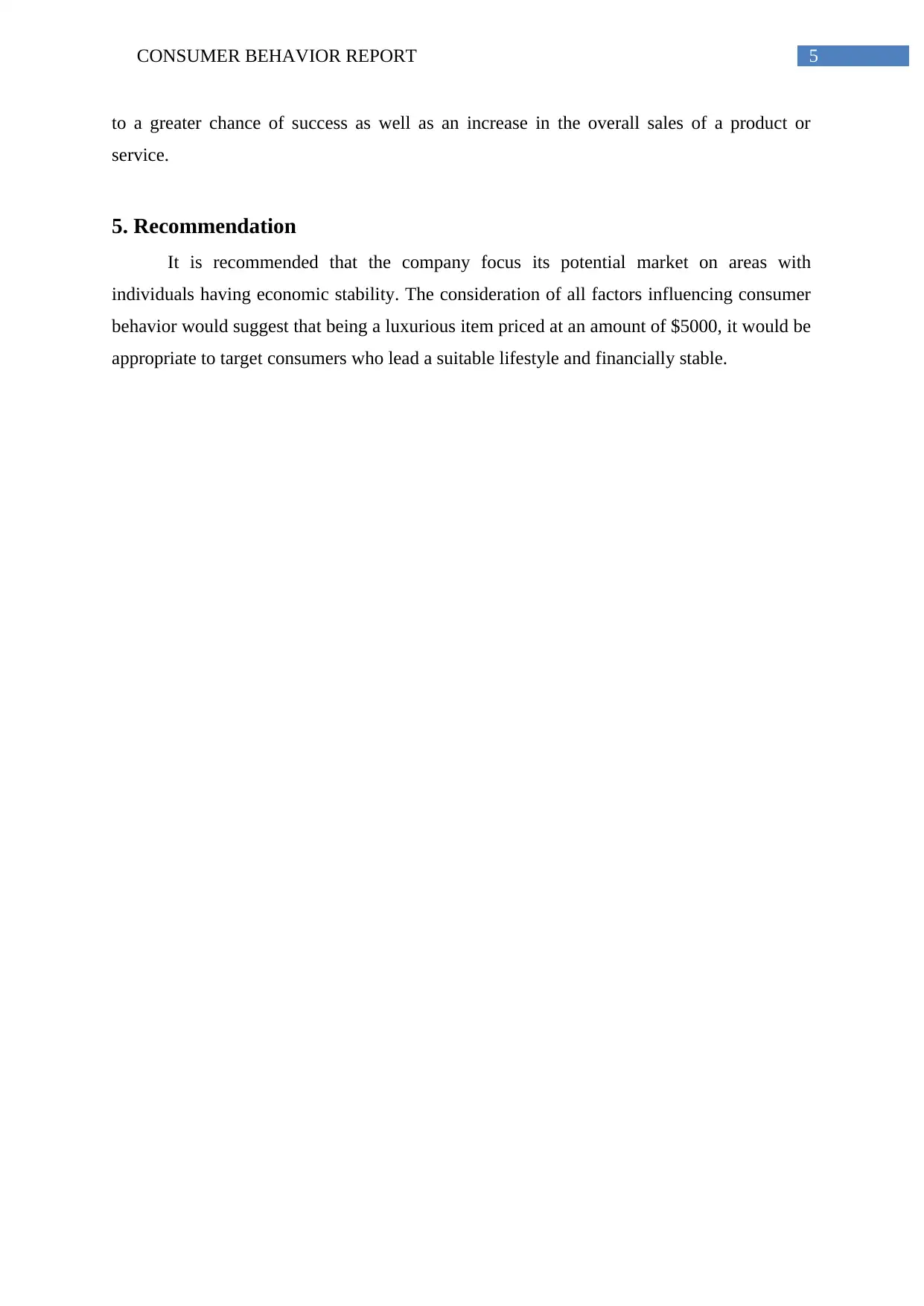
5CONSUMER BEHAVIOR REPORT
to a greater chance of success as well as an increase in the overall sales of a product or
service.
5. Recommendation
It is recommended that the company focus its potential market on areas with
individuals having economic stability. The consideration of all factors influencing consumer
behavior would suggest that being a luxurious item priced at an amount of $5000, it would be
appropriate to target consumers who lead a suitable lifestyle and financially stable.
to a greater chance of success as well as an increase in the overall sales of a product or
service.
5. Recommendation
It is recommended that the company focus its potential market on areas with
individuals having economic stability. The consideration of all factors influencing consumer
behavior would suggest that being a luxurious item priced at an amount of $5000, it would be
appropriate to target consumers who lead a suitable lifestyle and financially stable.
⊘ This is a preview!⊘
Do you want full access?
Subscribe today to unlock all pages.

Trusted by 1+ million students worldwide
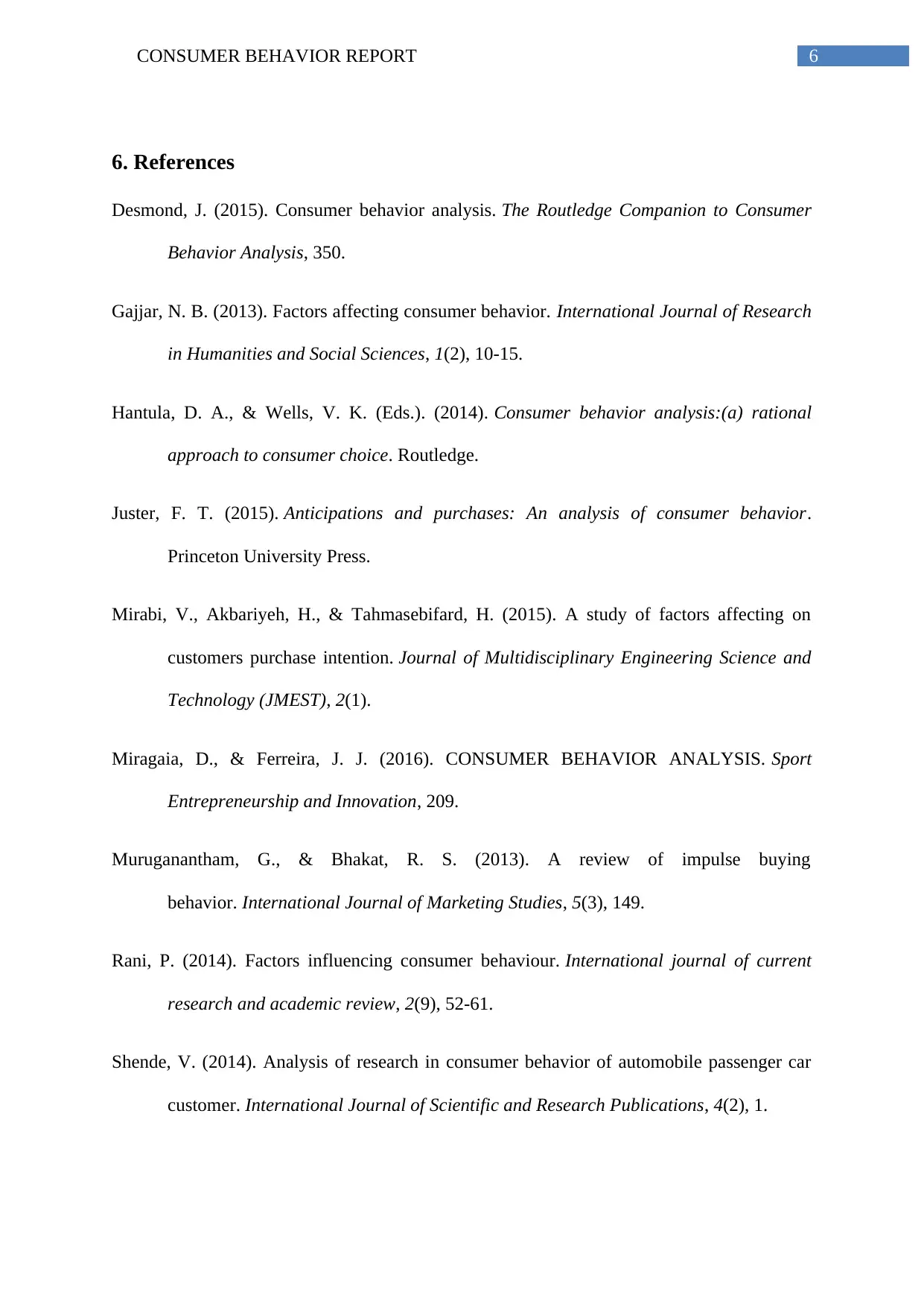
6CONSUMER BEHAVIOR REPORT
6. References
Desmond, J. (2015). Consumer behavior analysis. The Routledge Companion to Consumer
Behavior Analysis, 350.
Gajjar, N. B. (2013). Factors affecting consumer behavior. International Journal of Research
in Humanities and Social Sciences, 1(2), 10-15.
Hantula, D. A., & Wells, V. K. (Eds.). (2014). Consumer behavior analysis:(a) rational
approach to consumer choice. Routledge.
Juster, F. T. (2015). Anticipations and purchases: An analysis of consumer behavior.
Princeton University Press.
Mirabi, V., Akbariyeh, H., & Tahmasebifard, H. (2015). A study of factors affecting on
customers purchase intention. Journal of Multidisciplinary Engineering Science and
Technology (JMEST), 2(1).
Miragaia, D., & Ferreira, J. J. (2016). CONSUMER BEHAVIOR ANALYSIS. Sport
Entrepreneurship and Innovation, 209.
Muruganantham, G., & Bhakat, R. S. (2013). A review of impulse buying
behavior. International Journal of Marketing Studies, 5(3), 149.
Rani, P. (2014). Factors influencing consumer behaviour. International journal of current
research and academic review, 2(9), 52-61.
Shende, V. (2014). Analysis of research in consumer behavior of automobile passenger car
customer. International Journal of Scientific and Research Publications, 4(2), 1.
6. References
Desmond, J. (2015). Consumer behavior analysis. The Routledge Companion to Consumer
Behavior Analysis, 350.
Gajjar, N. B. (2013). Factors affecting consumer behavior. International Journal of Research
in Humanities and Social Sciences, 1(2), 10-15.
Hantula, D. A., & Wells, V. K. (Eds.). (2014). Consumer behavior analysis:(a) rational
approach to consumer choice. Routledge.
Juster, F. T. (2015). Anticipations and purchases: An analysis of consumer behavior.
Princeton University Press.
Mirabi, V., Akbariyeh, H., & Tahmasebifard, H. (2015). A study of factors affecting on
customers purchase intention. Journal of Multidisciplinary Engineering Science and
Technology (JMEST), 2(1).
Miragaia, D., & Ferreira, J. J. (2016). CONSUMER BEHAVIOR ANALYSIS. Sport
Entrepreneurship and Innovation, 209.
Muruganantham, G., & Bhakat, R. S. (2013). A review of impulse buying
behavior. International Journal of Marketing Studies, 5(3), 149.
Rani, P. (2014). Factors influencing consumer behaviour. International journal of current
research and academic review, 2(9), 52-61.
Shende, V. (2014). Analysis of research in consumer behavior of automobile passenger car
customer. International Journal of Scientific and Research Publications, 4(2), 1.
Paraphrase This Document
Need a fresh take? Get an instant paraphrase of this document with our AI Paraphraser
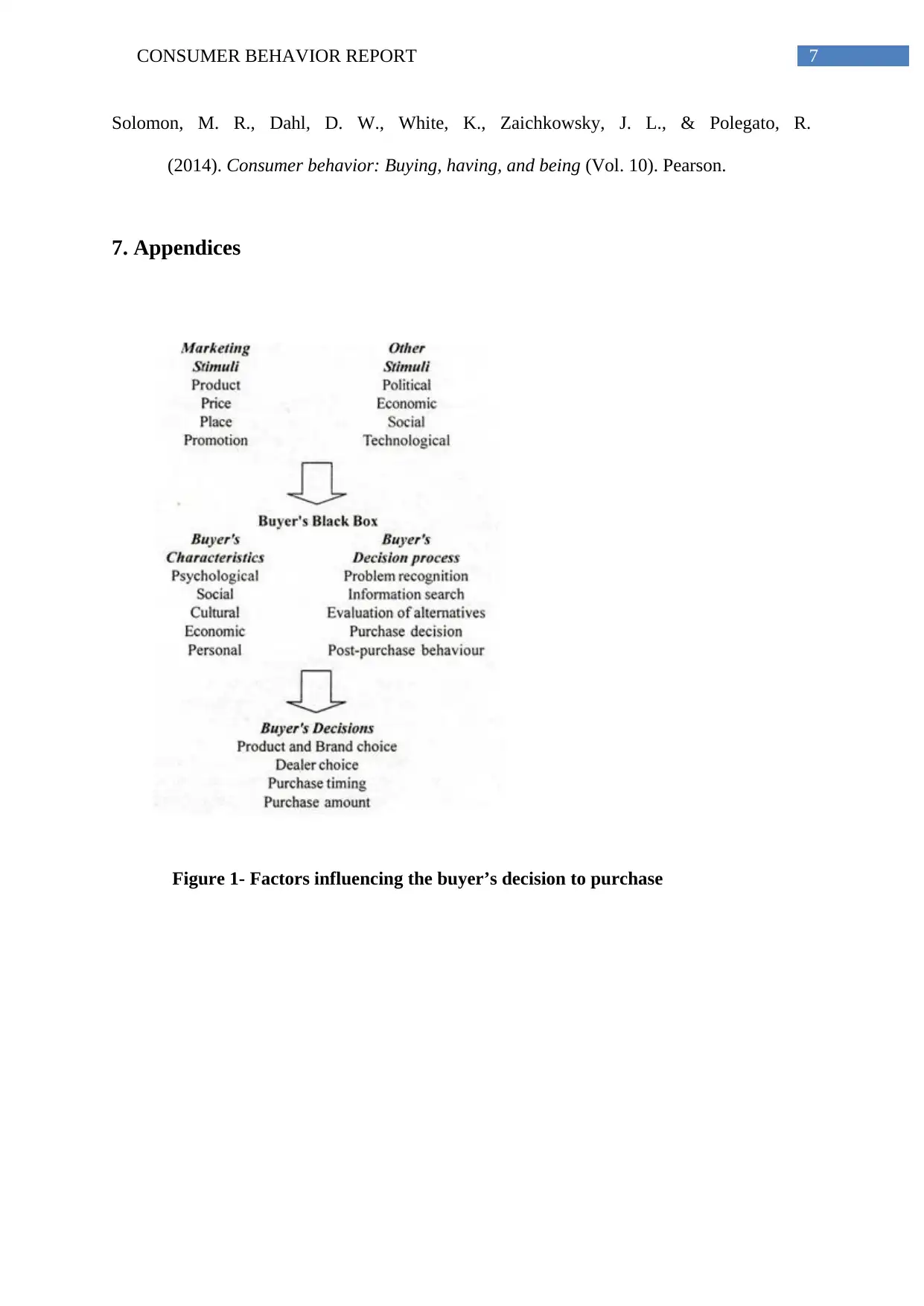
7CONSUMER BEHAVIOR REPORT
Solomon, M. R., Dahl, D. W., White, K., Zaichkowsky, J. L., & Polegato, R.
(2014). Consumer behavior: Buying, having, and being (Vol. 10). Pearson.
7. Appendices
Figure 1- Factors influencing the buyer’s decision to purchase
Solomon, M. R., Dahl, D. W., White, K., Zaichkowsky, J. L., & Polegato, R.
(2014). Consumer behavior: Buying, having, and being (Vol. 10). Pearson.
7. Appendices
Figure 1- Factors influencing the buyer’s decision to purchase
1 out of 8
Related Documents
Your All-in-One AI-Powered Toolkit for Academic Success.
+13062052269
info@desklib.com
Available 24*7 on WhatsApp / Email
![[object Object]](/_next/static/media/star-bottom.7253800d.svg)
Unlock your academic potential
Copyright © 2020–2025 A2Z Services. All Rights Reserved. Developed and managed by ZUCOL.





